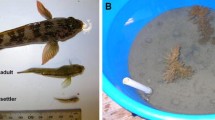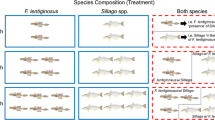Abstract
Estuarine assemblages of fishes and natant decapod crustaceans (i.e. nekton) comprise both permanent resident species and juveniles of coastal marine species that use estuaries primarily as nurseries. In an attempt to understand how the young of marine species successfully invade communities of permanent estuarine residents we studied potential interactions between two of the most abundant decapod crustaceans in nekton assemblages of the southeastern United States. Three years of quantitative samples from an intertidal marsh on Sapelo Island, Georgia showed that densities of the resident daggerblade grass shrimp Palaemonetes pugio were reduced during the time that juvenile white shrimp Penaeus setiferus used the estuary as a nursery. Results of a field enclosure experiment showed that white shrimp had no significant lethal or sublethal effects on adult grass shrimp. However, they did reduce survival of both juvenile and larval grass shrimp in laboratory experiments, suggesting the potential importance of a stage-dependent predatorprey interaction between the two shrimp species. The mortality rate of young grass shrimp in the presence of white shrimp was unaffected by grass shrimp density, but larvae (2.6–3.0 mm) suffered higher mortalities than did juveniles (5.0–15.0 mm). We suggest that the vulnerability of grass shrimp to predation by white shrimp is related to their molting cycle. The ‘window of vulnerability’ opens more often for younger grass shrimp because they molt more frequently. When combined with losses due to other predators and competitors, the impact of early white shrimp cohorts on grass shrimp larvae and juveniles may prevent the resident species from maintaining its population at high densities, thereby freeing resources in the nursery for subsequent cohorts of juvenile white shrimp.
Similar content being viewed by others
References
Alon NC (1987) The life history dynamics of the grass shrimp, Palaemonetes pugio Holthuis, in the laboratory. PhD dissertation, University of South Carolina, Columbia, SC
Alon NC, Stancyk SE (1982) Variation in life-history patterns of the grass shrimp Palaemonetes pugio in two South Carolina estuarine systems. Mar Biol 68: 265–276
Anderson G (1985) Species profiles: life histories and environmental requirements of coastal fishes and invertebrates (Gulf of Mexico) - grass shrimp. US Fish Wildl Serv Biol Rep 82(11.35), US Army Corps of Engineers, TR EL-82-4
Bell SS, Coull BC (1978) Field evidence that shrimp predation regulates meiofauna. Oecologia 35: 141–148
Boesch DF, Turner RE (1984) Dependence of fishery species on salt marshes: the role of food and refuge. Estuaries 7: 460–468
Bozeman EL Jr, Dean JM (1980) The abundance of estuarine larval and juvenile fish in a South Carolina intertidal creek. Estuaries 3: 89–97
Cattrijsse A, Makwaia ES, Dankwa HR, Hamerlynck O, Hemminga MA (1994) Nekton communities of an intertidal creek of a European estuarine brackish marsh. Mar Ecol Prog Ser 109: 195–208
Cohen J (1988) Statistical power analysis for the behavioral sciences, 2nd edn. Lawrence Erlbaum, Hillsdale, NJ
Day JW Jr, Hall CAS, Kemp WM, Yáñez-Arancibia A (1989) Estuarine ecology, Wiley, New York
Deegan LA (1993) Nutrient and energy transport between estuaries and coastal marine ecosystems by fish migration. Can J Fish Aquat Sci 50: 74–79
Freeman JA (1990) Molt increment, molt cycle duration, and tissue growth in Palaemonetes pugio Holthuis larvae. J Exp Mar Biol Ecol 143: 47–61
Haedrich RL (1983) Estuarine fishes. In: Ketchum BH (ed) Ecosystems of the world 26. Estuaries and enclosed seas. Elsevier, Amsterdam New York, pp 183–207
Hines AH, Lipcius RN, Haddon AM (1987) Population dynamics and habitat partitioning by size, sex and molt stage of blue crabs Callinectes sapidus in a subestuary of central Chesapeake Bay. Mar Ecol Prog Ser 36: 55–64
Hines AH, Haddon AM, Wiechert LA (1990) Guild structure and foraging impact of blue crabs and epibenthic fish in a subestuary of Chesapeake Bay. Mar Ecol Prog Ser 67: 105–126
Hunter J, Feller RJ (1987) Immunological dietary analysis of two penaeid shrimp species from a South Carolina tidal creek. J Exp Mar Biol Ecol 107: 61–70
Kneib RT (1985) Predation and disturbance by grass shrimp, Palaemonetes pugio Holthuis, in soft-substratum benthic invertebrate assemblages. J Exp Mar Biol Ecol 93: 91–102
Kneib RT (1987) Seasonal abundance, distribution and growth of postlarval and juvenile grass shrimp (Palaemonetes pugio) in a Georgia, USA, salt marsh. Mar Biol 96: 215–223
Kneib RT (1991) Flume weir for quantitative collection of nekton from vegetated intertidal habitats. Mar Ecol Prog Ser 75: 29–38
Kneib RT, Wagner SL (1994) Nekton use of vegetated marsh habitats at different stages of tidal inundation. Mar Ecol Prog Ser 106: 227–238
Leber KM (1985) The influence of predatory decapods, refuge, and microhabitat selection on seagrass communities. Ecology 66: 1951–1964
Lipcius RN, Herrnkind WF (1982) Molt cycle alterations in behavior, feeding and diel rhythms of a decapod crustacean, the spiny lobster Panulirus argus. Mar Biol 68: 241–252
Mayer MA (1985) Ecology of juvenile white shrimp (Penaeus setiferus) in the salt marsh habitat. MS thesis, Georgia Institute of Technology, Atlanta, Ga
McHugh JL (1967) Estuarine nekton. In: Lauff GH (ed) Estuaries (Publ no 83) American Association for the Advancement of Science, Washington, DC, pp 581–620
Mitsch WJ, Gosselink JG (1993) Wetlands. Van Nostrand Reinhold, New York
Mittelbach GG, Osenberg CW (1993) Stage-structured interactions in bluegill: consequences of adult resource variation. Ecology 74: 2381–2394
Morgan MD (1980) Grazing and predation of the grass shrimp Palaemonetes pugio. Limnol Oceanogr 25: 896–902
Nelson DM, Irlandi EA, Settle LR, Monaco ME, Coston-Clements LC (1991) Distribution and abundance of fishes and invertebrates in southeast estuaries. (ELMR Rep no 9) NOAA/NOS Strategic Environmental Assessments Division, Rockville, Md
Nelson WG (1981) Experimental studies of decapod and fish predation on seagrass macrobenthos. Mar Ecol Prog Ser 5: 141–149
Norušis MJ (1990) SPSS/PC+, Statistics 4.0 for the IBM PC/XT/AT and PS/2 [Subprogram of the Statistical Package for the Social Sciences]. SPSS Inc, Chicago
Olmi EJ III, Lipcius RN (1991) Predation on postlarvae of the blue crab Callinectes sapidus Rathbun by sand shrimp Crangon septemspinosa Say and grass shrimp Palaemonetes pugio Holthuis. J Exp Mar Biol Ecol 151: 169–183
Reaka ML (1976) Lunar and tidal periodicity of molting and reproduction in stomatopod crustacea: a selfish herd hypothesis. Biol Bull 150: 468–490
Ryer CH, Montfrans J van, Orth RJ (1990) Utilization of a seagrass meadow and tidal marsh creek by blue crabs Callinectes sapidus. II. Spatial and temporal patterns of molting. Bull Mar Sci 46: 95–104
Schindler DE, Johnson BM, MacKay NA, Bouwes N, Kitchell JF (1994) Crab: snail size-structured interactions and salt marsh predation gradients. Oecologia 97: 49–61
Sheridan PF, Livingston RJ (1979) Cyclic trophic relationships of fishes in an unpolluted, river-dominated estuary in north Florida. In: Livingston RJ (ed) Ecological processes in coastal and marine systems. Plenum Press, New York, pp 143–161
Sikora WB (1977) The ecology of Palaemonetes pugio in a southeastern salt marsh ecosystem with particular emphasis on production and trophic relationships. PhD dissertation, University of South Carolina, Columbia, SC
Snedecor GW, Cochran WG (1980) Statistical methods. The Iowa State University Press, Ames, Iowa
Sokal RR, Rohlf FJ (1981) Biometry — the principles and practice of statistics in biological research. Freeman, San Francisco
Stearns SC (1992) The evolution of life histories. Oxford University Press, Oxford
Stevens JP (1990) Intermediate statistics — a modern approach. Lawrence Erlbaum, Hillsdale, NJ
Tamm GR, Cobb JS (1976) Diel ecdysis rhythms in juvenile lobsters Homarus americanus. J Fish Res Board Can 33: 819–821
Thorp JH (1976) Interference competition as a mechanism of coexistence between two sympatric species of the grass shrimp Palaemonetes. J Exp Mar Biol Ecol 25: 19–35
Vance DJ (1992) Activity patterns of juvenile penaeid prawns in response to artificial tidal and day-night cycles: a comparison of three species. Mar Ecol Prog Ser 87: 215–226
Wassenberg TJ, Hill BJ (1993) Diet and feeding behaviour of juvenile and adult banana prawns Penaeus merguiensis in the Gulf of Carpentaria, Australia. Mar Ecol Prog Ser 94: 287–295
Weinstein MP (1979) Snallow marsh habitats as primary nurseries for fishes and shellfish, Cape Fear River, North Carolina. Fish Bull US 77: 339–357
Welsh BL (1975) The role of grass shrimp, Palaemonetes pugio, in a tidal marsh ecosystem. Ecology 56: 513–530
Werner EE, Gilliam JF (1984) The ontogenetic niche and species interactions in size-structured populations. Annu Rev Ecol Syst 15: 393–425
Williams AB (1984) Shrimps, lobsters, and crabs of the Atlantic coast of the eastern United States, Maine to Florida. Smithsonian Institution Press, Washington, DC
Wood CE (1967) Physioecology of the grass shrimp, Palaemonetes pugio, in the Galveston Bay estuarine system. Contrib Mar Sci Univ Texas 12: 54–79
Zimmer-Faust RK (1989) The relationship between chemoreception and foraging behavior in crustaceans. Limnol Oceanogr 34: 1367–1374
Author information
Authors and Affiliations
Rights and permissions
About this article
Cite this article
Kneib, R.T., Knowlton, M.K. Stage-structured interactions between seasonal and permanent residents of an estuarine nekton community. Oecologia 103, 425–434 (1995). https://doi.org/10.1007/BF00328680
Received:
Accepted:
Issue Date:
DOI: https://doi.org/10.1007/BF00328680




